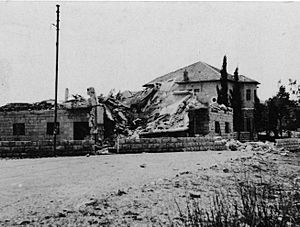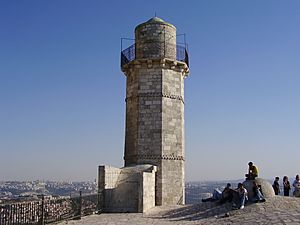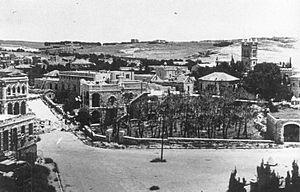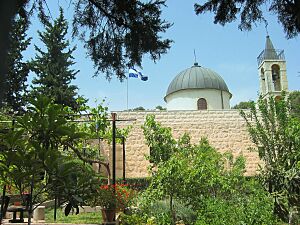Operation Yevusi facts for kids
Quick facts for kids Operation Yevusi |
|||||||
|---|---|---|---|---|---|---|---|
| Part of 1947–1948 Civil War in Mandatory Palestine | |||||||
 Katamon after Operation Yevusi |
|||||||
|
|||||||
| Belligerents | |||||||
|
|||||||
| Commanders and leaders | |||||||
| Yitzhak Sadeh |
Ibrahim Abu Daya Kamil Uraiqat (local irregulars) |
||||||
| Strength | |||||||
| Two brigades | unknown | ||||||
| Casualties and losses | |||||||
| Over 70 | Over 80 | ||||||
Operation Yevusi (which means "Jebusite" in Hebrew) was a military plan carried out by the Palmach during the 1948 Arab–Israeli War. Its main goal was to gain control for Jewish forces over key areas around Jerusalem. The operation was led by Yitzhak Sadeh. It lasted for about two weeks, from April 22 to May 3, 1948. Not all the goals were met because the British army stepped in and made both sides stop fighting.
Contents
History of Operation Yevusi
Operation Yevusi began after the Battle for Jerusalem. The plan had four main targets. These were:
- Nabi Samuel: An Arab village northwest of Jerusalem. It was the highest point in the area.
- Sheikh Jarrah: An Arab neighborhood north of the city walls. It controlled the road to Mount Scopus.
- Katamon: A neighborhood in southwest Jerusalem, mostly home to Arab Christians.
- Augusta Victoria: An area east of the Old City.
Battles at Nabi Samuel and Sheikh Jarrah
The Harel Brigade arrived in Jerusalem on April 21. Their journey to the city took eight hours under fire. The next day, they started attacking the high ground of Nabi Samuel. However, on April 23, a group from Harel was caught in an ambush. They had to retreat, losing many soldiers.
On the night of April 24-25, Commander Sadeh's forces took control of Sheikh Jarrah. During this action, about 40 Arabs were killed, and 20 homes were destroyed.
General Macmillan, who led the British forces in Palestine, asked the Jewish forces to leave Sheikh Jarrah. He said the British army needed that road to reach the northern part of the country. Macmillan promised to stop Arab fighters from returning. After the British Army started firing, the Palmach pulled back. The British then declared Sheikh Jarrah a neutral zone. This meant no armed soldiers from either side could enter.
Battle for Katamon
On April 29, one week after Operation Yevusi started, Sadeh changed the focus to Katamon. The main target there was the Greek Orthodox San Simon monastery. This monastery was defended by local Arab fighters and some volunteers from Iraq. There was also a small group from the Arab Legion guarding the empty Iraqi Consulate nearby. John Bagot Glubb, a British officer leading the Arab Legion, ordered his troops to leave after the surrounding buildings were taken.
The attack on Katamon began with heavy mortar and machine gun fire. Then, soldiers from Harel's 4th and 5th Battalions, along with Etzion's 4th Battalion, moved in. About 120 soldiers attacked from the north and west. The fight for the monastery lasted all day. Some reports say 40 Jewish fighters were killed, while others give lower numbers. One source states that 80 Arabs were killed.
On the evening of April 30, two large explosions shook the area. By May 1, the Jewish forces had full control of Katamon. Again, the British stepped in and demanded a ceasefire. But this time, the Jewish forces remained in control of the area they had captured. While the battle for Katamon was happening, Arabs in the Old City fired at Jewish positions in Yemin Moshe. This firing only stopped after the British Army took action.
Aftermath of the Operation
Since the operation was only partly successful, Sadeh left Jerusalem. Dov Joseph, who was the military governor of Jerusalem, sent teams into Katamon. Their job was to find all the food they could. This was to help with the severe food shortages caused by an Arab blockade, which led to strict food rationing in March 1948. After the battle, the district was searched for food and supplies.
By the end of the war, Israel controlled 12 of Jerusalem's 15 Arab residential areas. It is thought that at least 30,000 people became refugees. About 750 non-Jews stayed in the areas that were taken. Many of these were Greeks living in the Greek Colony.
Awards and Medals
Soldiers who took part in these events received special awards.
Israel
 Haganah Ribbon - Given to anyone who served in the Haganah for at least six months between 1920 and 1948.
Haganah Ribbon - Given to anyone who served in the Haganah for at least six months between 1920 and 1948. Decoration of State Warriors - Given to members of military groups who fought to create the state of Israel.
Decoration of State Warriors - Given to members of military groups who fought to create the state of Israel. Defence of Jerusalem Badge - Given to every soldier who served in the Jerusalem area between April 1 and June 10, 1948.
Defence of Jerusalem Badge - Given to every soldier who served in the Jerusalem area between April 1 and June 10, 1948. Katamon Medal - This medal was first made in May 1948 and given to soldiers who fought in the battle in July 1949. However, the IDF later stopped recognizing this medal.
Katamon Medal - This medal was first made in May 1948 and given to soldiers who fought in the battle in July 1949. However, the IDF later stopped recognizing this medal.
United Kingdom (Including Arab Legion)
See also
- Depopulated Palestinian locations in Israel




